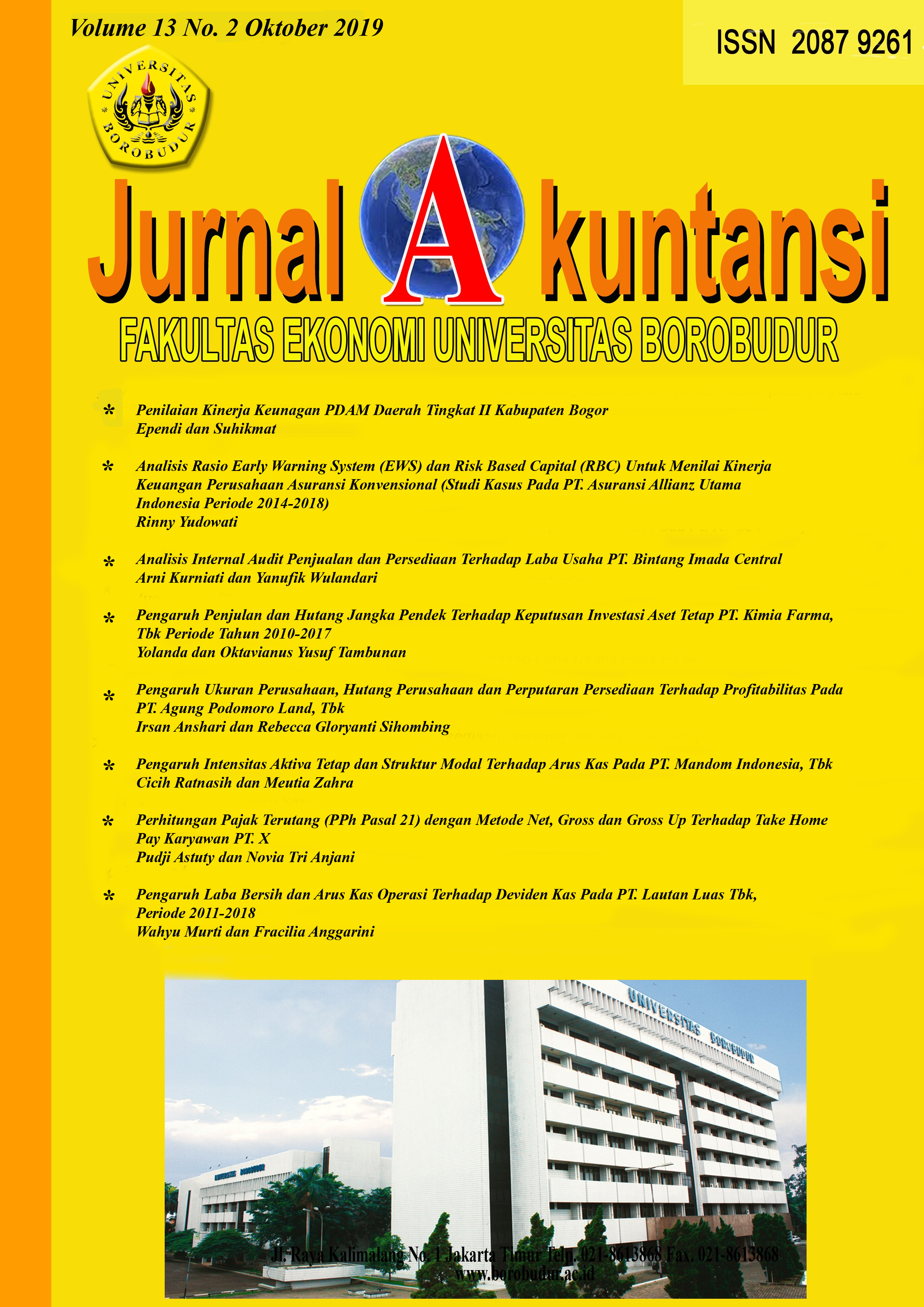PENGARUH PENJUALAN DAN HUTANG JANGKA PENDEK TERHADAP KEPUTUSAN INVESTASI ASET TETAP PT. KIMIA FARMA TBK PERIODE TAHUN 2010-2017
Abstract
This study aims to determine whether Sales (X1) and Short-term Debt (X2) both partiallyand simultaneously have a significant effect on the Decision of Fixed Asset Investment at PTKimia Farma Tbk which is listed on the Indonesia Stock Exchange (IDX).The data analysis method used is the classic assumption test, multiple linear regressionanalysis and hypothesis testing with the E-views program 9. The data used in this study aresecondary data, by collecting PT Kimia Farma Tbk's quarterly financial statements in the form ofbalance sheets and annual income statements. 2010 to 2017 which are listed on the IndonesiaStock Exchange. The sample used in this study is a quarterly financial statement in the form of abalance sheet and income statement of PT Kimia Farma Tbk from 2010 to 2017.The results of the F test in this study have a coefficient of 325.7019 with a prob (F-statistic)of 0.0000.000 <0.05. This result means that the independent variables (sales and short-term debt)simultaneously or jointly have a significant influence on the fixed asset investment decisions. Thet-test results partially indicate the level of significance obtained from the independent variable,namely sales of 0.0092 and short-term debt of 0.0000. This shows that short-term sales and debthave a significant effect in improving fixed asset investment decisions.Based on the results of the study, the researchers suggest that investors should pay attentionto the value of sales and short-term debt before making a decision to invest. For futureresearchers, it should add or multiply the independent variables that are still based on financialstatements other than those used in this study while remaining based on previous studies.Keywords: Sales, Short-term Debt and Fixed Asset Investment Decisions.References
Aini, S. N. (2013). Faktor-Faktor yang
Mempengaruhi Underpricing Saham
pada Perusahaan IPO di BEI Periode
-2011. Jurnal Ilmu Manajemen
(JIM), 1.
Anjani, B. B. (2012). Analisis Faktor-Faktor
yang Berpengaruh terhadap Keputusan
Investasi pada Perusahaan Food and
Beverages di Bursa Efek Indonesia.
Diponegoro University. Retrieved from
http://eprints.undip.ac.id/37317/
Arikunto, S. 2006. Metode Penelitian
Kualitatif. Jakarta: Bumi Aksara
Astuti, Partiwi Dwi. (2012). “Akuntansi
Keuangan Dasar: Teori dan Kasus”.
Yogyakarta: CAPS.JURNAL AKUNTANSI FE-UB
Vol. 13 No. 2 Oktober 2019 56
Baskin, J. (1989). An Empirical Investigation
of the Pecking Order Hypothesis.
Financial Management, 18(1), 26–35.
Retrieved from
www.jstor.org/stable/3665695
Bustami, Bastian dan Nurlela, 2009.Akuntansi
Biaya, edisi pertama, Mitra Wacana
Media, Jakarta.
Budiman, T. T. (2009). Analisis Rencana
Investasi Penambahan Mesin pada PT
Anugrah Sejati Embroidery. Universitas
Atma Jaya Yogyakarta. Retrieved from
http://e-journal.uajy.ac.id/id/eprint/2735
Dharmmesta, Basu Swastha. 2011. Materi
Pokok Manajemen Pemasaran, Edisi
Kedua Cetakan Pertama. Jakarta:
Universitas Terbuka.
Fahmi & Hadi. 2011.Teori Portofolio dan
Analisis Investasi. Edisi
Bandung:Alfabeta.
Fazzari, S. M., Hubbard, R. G., Petersen, B.
C., Blinder, A. S., & Poterba, J. M.
(1988). Financing Constraints and
Corporate Investment. Brookings Papers
on Economic Activity, (1), 141–206.
https://doi.org/10.2307/2534426
Harahap, Sofyan Syafri. 2006. Analisis Kritis
Atas Laporan Keuangan. Jakarta: PT.
Raja Grafindo Persada.
Hery. (2012). Akuntansi Inti Sari Konsep
Dasar Akuntansi. Jakarta: Prenada.
Hidayat, R. (2010). Keputusan Investasi dan
Financial Costraints: Studi Empiris pada
Bursa Efek Indonesia. Buletin Ekonomi
Moneter Dan Perbankan, 1(April), 457–
https://doi.org/https://doi.org/10.21098/b
emp.v12i4.249
Horne, J. C. Van, & Wachowicz, J. M. (2012).
Prinsip-prinsip Manajemen Keuangan
(13th ed.). Jakarta: Salemba Empat.
Husnan, Suad. (2008). Manajemen Keuangan:
Teoridan Penerapan Buku 1. Edisi
BPFE.Yogyakarta.
Jummulyanti, & Linda, M. R. (2015).
Pengaruh Hutang dan Kesempatan
Investasi terhadap Keputusan Investasi
Perusahaan Property dan Real Estate
yang Terdaftar di Bursa Efek Indonesia.
Jurnal Praktik Bisnis, 4(Mei), 87–96.
Kieso, Donald E., Jerry J. Weygandt, dan
Terry D. Warfield, 2007. Akuntansi
Intermediete, Terjemahan Emil Salim,
Jilid 1, Edisi Kesepuluh, Penerbit
Erlangga, Jakarta.
Kieos, Donald E., Jerry J. Weggan and Terry
D. Wrfield, 2010, Intermediate
Accounting, 13th Ed: America : John
Willey and Sons, Inc.
Martono dan Harjitno, D. Agus. 2010.
Manajemen Keuangan. Yogyakarta:
Ekonisia.
Munawir. 2007. Analisis Laporan Keuangan.
Yogyakarta : Edisi Empat, Liberty.
Myers, S. C., & Majluf, N. S. (1984).
Corporate Financing and Investment
Decisions When Firms Have
Information that Investors Do not Have.
Journal of Financial Economics, 13(2),
–221. https://doi.org/10.1016/0304-
X(84)90023-0
M. Hanafi, Mamduh dan Halim, Abdul. 2007.
Analisis Laporan Keuangan.
Yogyakarta: UPP STIM YKPN.
Nguyen, P. D., & Dong, P. T. A. (2013a).
Determinants of Corporate Investment
Decisions : The Case of Vietnam.
Journal of Economics and Development,
(1), 32–48.
Rahmiati, & Huda, P. H. (2015). Pengaruh
Kebijakan Dividen, Kesempatan
Investasi, dan Profitabilitas Terhadap
Keputusan Investasi. Jurnal Kajian
Manajemen Bisnis, 4(2).
Rakhimsyah dan Gunawan. 2011. Pengaruh
Keputusan Investasi, Keputusan
Pendanaan, Kebijakan Deviden dan
Tingkat Suku Bunga Terhadap Nilai
Perusahaan. Jurnal Investasi. Vol. 7 No.
Hal. 31-45.
Reeve, Warren and Fess di alih bahasakan
oleh Aria Farahmita, Amunungrahani
dan taufik Hendrawan. 2016. Pengantar
Akuntansi-Adaptasi Indonesia, Edisi 2
Buku 1, Jakarta: Salemba Empat.JURNAL AKUNTANSI FE-UB
Vol. 13 No. 2 Oktober 2019 57
Sajid, M., Mahmood, A., & Sabir, H. M.
(2016). Does Financial Leverage
Influence Investment Decisions?
Empirical Evidence From KSE-30 Index
of Pakistan. Asian Journal of Economic
Modelling, 4(2), 82–89.
https://doi.org/10.18488/journal.8/2016.
2/8.2.82.89
Vogt, S. C. (1994). The Cash Flow/
Investment Relationship: Evidence from
U.S. Manufacturing Firms. Financial
Management, 23(2), 3–20.
Wahyuni, S., Arfan, M., & Shabri, M.
(2015a). Pengaruh Kepemilikan
Manajerial, Kepemilikan Institusional,
Financial Leverage, dan Profitabilitas
terhadap Keputusan Investasi
Perusahaan Manufaktur di Indonesia.
Jurnal Administrasi Akuntansi, 4, 51–
Widarjo, W., & Setiawan, D. (2009).
Pengaruh Rasio Keuangan terhadap
Kondisi Financial Distress Perusahaan
Otomotif. Jurnal Bisnis Dan Akuntansi,
(2), 107–119.
Yunus, R. S. (2017). Pengaruh Leverage dan
Profitabilitas terhadap Keputusan
Investasi. Equity, 3(2), 81–97.
Zaki, M. (2013). Pengaruh Arus Kas,
Kesempatan Investasi, Leverage, dan
Modal Kerja terhadap Keputusan
Investasi Aktiva Tetap pada Perusahaan
Financially Constrained. Jurnal Ilmu
Manajemen (JIM), 1(1).
Zen, S. D., & Herman, M. (2007). Pengaruh
Harga Saham, Umur Perusahaan, dan
Rasio Profitabilitas Perusahaan terhadap
Tindakan Perataan Laba yang Dilakukan
Oleh Perusahaan Perbankan yang
Terdaftar di Bursa Efek Jakarta. Jurnal
Akuntansi Dan Manajemen, 2(2), 57–71.

